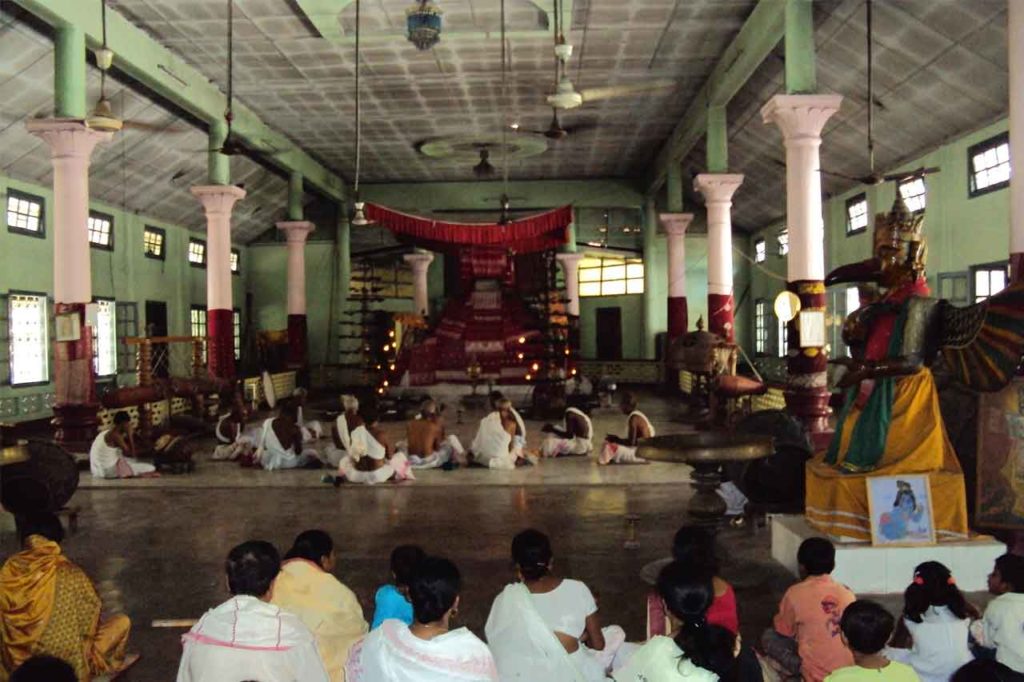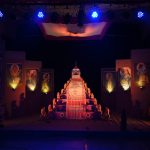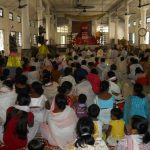Srimanta Sankaradeva was such a genius, who had no equal either in his contemporary period or in subsequent times. His multifaceted activities have left indelible marks on the socio-cultural sphere of Assam and also some parts of North India. His works encompassed the realm of literature, painting, sculpture, dance, music, drama, architecture, social reform etc. That he did all these works by staying about half of his life in a small hamlet named Tembuwani (later known as Batadrava or Bardowa) in present Nagaon district of Assam itself is a great wonder.
The principles and ideologies underlying Srimanta Sankaradeva’s activities were those of Eka Sarana, the concept of submitting oneself to the single supreme entity of this universe. In fact the religious order founded by him was known as Eka Sarana Nāma Dharma. This concept of single supreme entity is derived originally from the Veda, which says that a single ultimate entity pervades every creation, both sentient and insentient beings.1 Srimanta Sankaradeva only restored that concept in an era clouded by the atrocious rituals of innumerable deities, which had been designed by the greedy priest community in order to fulfil their own pecuniary requirements. He preached the concept of devotion to one God, lord Krishna or Vishnu, which is derived from the Veda. The Rigveda explicitly says that the same ultimate entity is expressed by different people as different entities.
Ekang sat vipra bahudhā badanti
(Rigveda/1/164/46)
This subscription to the Vedic ideology proves that Srimanta Sankaradeva was part of the great Indian spiritual culture that had once flourished in the Indus valley and elsewhere of Bhāratavarsha. An important aspect of Srimanta Sankaradeva’s ideology is his belief in a united spiritual Bhāratavarsha. In his writings he alluded to Assam, the province he lived in only once. This allusion is found in his rendering of Bhāgavata. In a verse, he described different ethnic groups who lived in Assam in that period.2 But there was no evidence in his writings of any personal affinity of him to this land. So it was only a statement, where there was no passion. Against that, he mentioned the name Bhāratavarsha several times and that too passionately, even though there was no single kingdom or empire named Bhāratavarsha at that time. Evidently, he believed in the cultural unity of the people living in the Indian peninsula, which made them part of a spiritual empire named Bhāratavarsha inherited from the days of the two great epics. This is a unique thing found in Srimanta Sankaradeva’s writings. This proves his pan-Indian vision, the like of which is missing among most of the people even now.
It was because of the love and affection for the Indian culture and spiritual heritage that Srimanta Sankaradeva toured the length and breadth of the Indian peninsula. No one had under taken such extensive tour before him except Adi-Sankaracharya. Later Swami Vivekananda repeated that feat. This country-wide pilgrimage was a clear proof of the saint’s pan-Indian vision. He undertook this tour from 1481 AD to 1493 AD.3
The Bhakti movement launched by Srimanta Sankaradeva had its impact on different parts of Bhāratavarsha. The places, which bear marks of his impact even today are Odisha, Mithila, Bengal, Vrindavana, and Rajputna. The social institution named Bhāgavata Tungi in Odisha was an influence of the saint. Sant Jagannath Das of Orissa, who had founded the Atibari cult had learnt to read Bhâgavata near Srimanta Sankaradeva, when the latter was staying at Puri during his twelve year long pilgrimage from 1481 AD to 1493 AD.4 It is significant that the basic principles of the Atibari cult resemble those of the Eka Sarana Nāma Dharma founded by Srimanta Sankaradeva. It may be mentioned that the religious order Eka Sarana Nāma Dharma had come into being in 1468 AD, when Srimanta Sankaradeva initiated the first batch of his disciples at Tembuwani.5 So the Eka Sarana Nāma Dharma cult was certainly older than the Atibari cult. The introduction of the Bhāgavata Tungi institution in Odisha by Jagannath Das can therefore be attributed to the influence of Srimanta Sankaradeva.
It was because of Srimanta Sankaradeva that the lost glory of Vrindavana, a great place of pilgrimage for all Indians was restored. This place was devastated by the Islamic invasion in the medieval period. Rupa Goswami, a disciple of Srimanta Sankaradeva took up the initiative to reconstruct the places of worship in Vrindavana all over again. Though he became attracted to Chaitanyadeva in the intermittent period of two pilgrimages of Srimanta Sankaradeva, he remained ever respectful to Srimanta Sankaradeva and considered him as an incarnation of God. Rupa Goswami wrote a verse accordingly in his play Bidagdha Mādhava Nātaka.6 Similarly, another follower of Srimanta Sankaradeva’s Eka Sarana Nāma Dharma, King Bhagyachandra of Manipur restored the devastated town of Nabadwipa in Bengal.7 The followers of Srimanta Sankaradeva would not have embarked on such activities had the saint been parochial and sub-nationalist.
For Srimanta Sankaradeva, entire humanity was the targetted group. He addressed the entire humanity in his writings.8 He did not address the people of Assam, not even the people of Bhāratavarsha. But there was no contradiction of this approach with his use of the word Bhāratavarsha repeatedly. He considered Bhāratavarsha as a holy place to be born in, but did not confine his love and affection to those living in Bhāratavarsha alone.
On the cultural front, Srimanta Sankaradeva helped the drama movement grow in entire India. He was the first playwright in all modern Indian languages. His plays, known as Ankiyā plays were enacted in all over Northern India. That was why several centuries of the drama movement in Bengal came to be known by a play Kāliya Damana, authored by Srimanta Sankaradeva. They even derived the word Yātrā from the saint’s plays. The playwrights of Mithila, the most developed intellectual centre of medieval Bhāratavarsha acknowledged the saint as the person who moulded their plays. The characteristics of the Maithili plays resembled those of the Ankiyā plays.9
Another impact on the cultural front was the influence of the paintings created by Srimanta Sankaradeva on other regions. The Rajputna paintings were the clear examples of such influence. The concept of the flying angels in Hawa Mahal came from the flying entities carved in the sculptures of Sankari institutions. The scroll paintings of Bengal was a direct offshoot of the art movement launched by the saint, who was a pioneer of scroll painting in medieval Bhāratavarsha. The design of crown as depicted in the Kangra school of art was derived from the Sankari school of painting.10
Srimanta Sankaradeva achieved an unique feat. He blended all the main streams of Indian philosophy in his religious philosophy. That too was done in a coherrent and consistent manner. Therefore we find elements of monism, qualified monism etc in his writings without any contradiction among these elements. So his contribution to the realm of Indian philosphy is unprecedented. His religious philosophy, which the present author has termed Vivartanavāda, comprises of the following basic characteristics :
(1) Brahman is the supreme truth.
(2) Brahman and Iswara (God) are the same.
(3) Brahman or Iswara is there in every being.
(4) Iswara and His creations are not different.
(5) Jiva (creature) is a component of God. The former constitutes the body of the latter.
(6) The creation is temporary, but not unreal.
(7) Māyā (illusion) is an attribute of God. Its influence can be avoided by the grace of God.
(8) One becomes God as one realises the identity of God and the five elements.
Thus the religious philosophy of Srimanta Sankaradeva represent the best of the ancient Indian thought. It also proves that he belonged to the genre of the Upanishadic seers. Little wonder, even Sant Kabir termed him as Tribhuvanapati or God.11 It was in the Upanishadic tradition that one who knew Brahma became Brahma. So there was nothing wrong in terming Srimanta Sankaradeva as God.
Srimanta Sankaradeva was a great humanitarian. So he addressed the entire humanity in his writings, not the population of any region like Assam or even Bhāratavarsha. He called upon the entire humanity to worship lord Hari.12 It was this love for the entire humanity that propelled him to oppose all types of killings. He said several times in his writings that one should not sacrifice any creature, because that creature in turn tortures the sacrificer in the other world.13 This concept confers equality upon all creatures, not only among human beings. This was a unique approach, not seen even among the great humanitarian souls. This clarion call by the saint was necessitated by the grave social situation prevailing in the Brahmaputra valley in those times. Even human beings were sacrificed before the deity by the Tantrics, who called the shots in the society.
Srimanta Sankaradeva was a pioneer in the international movement for equal rights to women. He had supported the cause of women, centuries before the Western authors like John Locke (1632-1704), Mary Wollstonecraft, John Stuart Mill, Kodse, Simone-De-Beauvoir, Betty Friedan, John Survey etc took it up. The saint emphatically said that women should be educated, way back in fifteenth century itself, when even the majority of the male population itself was uneducated.14 This proves that Srimanta Sankaradeva was a pioneer in women liberation in the entire world. He even departed from the original writing by Valmiki in his rendering of Rāmāyana Uttarākānda in order to protest the injustice meted out to Sita by lord Rama.15 This was certainly a radical action by a religious precher. Clearly Srimanta Sankaradeva was different from the run of the mill religious preachers.
Srimanta Sankaradeva was an egalitarian in heart. He always espoused the cause of the downtrodden. He had the moral courage to refuse to accept even an emperor as his disciple since he felt that the democratic character of his order would be compromised.16 All devotees in his order have to sit together at the same level inside the Kirtanaghar, the community prayer-hall. There was no difference of caste or class. The downtrodden in the society got equal status as that of the highly priviledged class of the society in Srimanta Sankaradeva’s place. These were the early elements of socialism, albeit with belief in God. So the saint can be called a pioneer of the concept of socialism too.17 His vision was to establish a classless society, because he explicitly said that Nabāsai bhakati jāti ajāti which meant that devotion did not differentiate between the classes.18 But he did not talk about annihilation of the upper classes like the Bolsheviks. His way to socialism was through cleansing of heart. It continues to be a matchless innovation even now.
References and notes
1. Vedic thoughts in Srimanta Sankaradeva’s writings, Dr Sanjib Kumar Borkakoti, in Setubandha, edited by Ramesh Chandra Bora, Dhekiajuli, October 13, 2006 AD.
2. Bhāgavata, Verse 2/53, in Mahāpurusha Srimanta Sankaradeva Vākyāmrita, Srimanta Sankaradeva, edited by Dr Dharmeswar Chutiya, First edition, Nagaon, 1998 AD, p. 249.
3. Jagadguru Sankaradeva, Dr Sanjib Kumar Borkakoti, First edition, Guwahati, 2004 AD, p. 13.
4. Sankar Gosāi Charit, Govinda Nayak, edited by Pandit Bani Bhushan Shastri, First edition in Assamese script, Guwahati, 2005 AD, p. 23. Govinda Nayak was an Oriya author, who wrote this hagiography in Brajawali language and Oriya script in the sixteenth century.
5. Mahapurusha Srimanta Sankaradeva, Dr Sanjib Kumar Borkakoti, First edition, Guwahati, 2005 AD, pp. 17-19.
6. Unique contributions of Srimanta Sankaradeva in religion and culture, Dr Sanjib Kumar Borkakoti, First edition, Nagaon, 2006, p. 126.
7. Ibid, pp. 128-129.
8. Bhāgavata, Verse 2/124, in Mahāpurusha Srimanta Sankaradeva Vākyāmrita, Srimanta Sankaradeva, edited by Dr Dharmeswar Chutiya, First edition, Nagaon, 1998 AD, p. 255. The saint addressed the humanity as Obā Naraloka.
9. Unique contributions of Srimanta Sankaradeva in religion and culture, Dr Sanjib Kumar Borkakoti, First edition, Nagaon, 2006, pp. 83-84, 129.
10. Sarbabhāratiya prekshāpatat Srimanta Sankaradevar sthān, Dr Sanjib Kumar Borkakoti, speech delivered at Mahapurusha Sankaradeva Kala Kristi Govesana Kendra, Jorhat, June 5, 2004.
11. Ibid.
12. Bhāgavata, Verse 2/124, in Mahāpurusha Srimanta Sankaradeva Vākyāmrita, Srimanta Sankaradeva, edited by Dr Dharmeswar Chutiya, First edition, Nagaon, 1998 AD, p. 255.
13. Nimi Navasiddha Sambāda, Verse 357-359, in Mahāpurusha Srimanta Sankaradeva Vākyāmrita, Srimanta Sankaradeva, edited by Dr Dharmeswar Chutiya, First edition, Nagaon, 1998 AD, p. 766.
14. Nimi Navasiddha Sambāda, Verse 333, in Mahāpurusha Srimanta Sankaradeva Vākyāmrita, Srimanta Sankaradeva, edited by Dr Dharmeswar Chutiya, First edition, Nagaon, 1998 AD, p. 764.
15. Sankaradevar Sitā : pratibādar pratik, Gitanjali Hajarika, in Purbanchal Abhimat, edited by Dr Lakshminandan Bora, Guwahati, November 19, 2005 AD.
16. Jagadguru Sankaradeva, Dr Sanjib Kumar Borkakoti, First edition, Guwahati, 2004 AD, pp. 61-62.
17. Sankaradevar Ekasaranatattva, Dr Sanjib Kumar Borkakoti, 1st edition, Moran, 2003, p. 18-21.
18. Kirtana-Ghoshā, Srimanta Sankaradeva, Verse 129.




